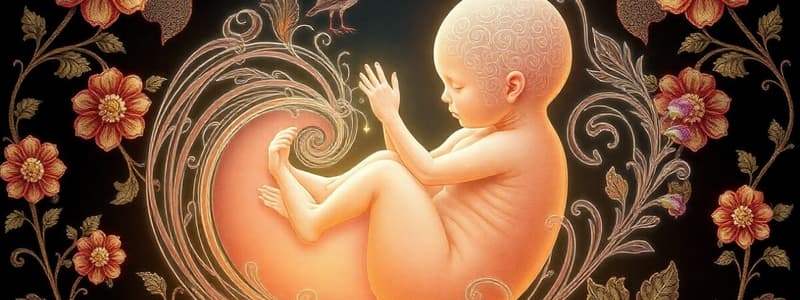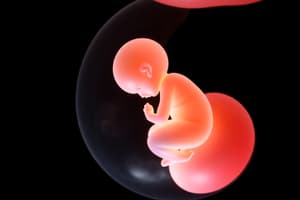Podcast
Questions and Answers
Which process primarily facilitates the movement of the embryo from the oviduct to the uterus?
Which process primarily facilitates the movement of the embryo from the oviduct to the uterus?
- The secretion of hormones that attract the embryo.
- Diffusion of the embryo through the reproductive tract.
- Muscular contractions of the uterus.
- Beating of cilia lining the oviduct. (correct)
What is the main source of nourishment for the embryo during its initial stages of development while it is travelling through the oviduct?
What is the main source of nourishment for the embryo during its initial stages of development while it is travelling through the oviduct?
- Materials absorbed directly from the uterine wall.
- Blood supply from the mother.
- Amniotic fluid present in the oviduct.
- Nutrient-rich cytoplasm of the egg. (correct)
During which process does the embryo attach to the uterine wall, establishing a crucial connection for further development?
During which process does the embryo attach to the uterine wall, establishing a crucial connection for further development?
- Ovulation
- Implantation (correct)
- Gastrulation
- Fertilization
What key developmental milestone defines the end of the embryonic stage and transition to the fetal stage?
What key developmental milestone defines the end of the embryonic stage and transition to the fetal stage?
How does the amniotic fluid contribute to the protection and development of the fetus?
How does the amniotic fluid contribute to the protection and development of the fetus?
If fertilization occurs on day 1, approximately when would the developing organism transition from the embryonic to the fetal stage?
If fertilization occurs on day 1, approximately when would the developing organism transition from the embryonic to the fetal stage?
Assuming a normal pregnancy, if the first day of a woman's last menstruation was January 1st, on approximately what date would the baby be expected to be born?
Assuming a normal pregnancy, if the first day of a woman's last menstruation was January 1st, on approximately what date would the baby be expected to be born?
What would be a cause for concern if an ultrasound performed at 30 weeks of gestation estimates the fetal weight to be 1.5 kg?
What would be a cause for concern if an ultrasound performed at 30 weeks of gestation estimates the fetal weight to be 1.5 kg?
Flashcards
Embryo
Embryo
An organism in the early stages of development before birth.
Implantation
Implantation
The process where the embryo attaches to the wall of the uterus.
Fetus
Fetus
An unborn organism in the later stages of development.
Amnion
Amnion
Signup and view all the flashcards
Amniotic Fluid
Amniotic Fluid
Signup and view all the flashcards
Gestation
Gestation
Signup and view all the flashcards
Zygote
Zygote
Signup and view all the flashcards
Oviduct
Oviduct
Signup and view all the flashcards
Study Notes
- After fertilization, the zygote divides repeatedly by mitosis for several hours.
- This division gives rise to the embryo, which is a ball of cells.
- An embryo is an organism in a very early stage of development, before birth.
- The embryo moves down the oviduct to the uterus.
- Cilia lining the oviduct facilitates this movement.
- The embryo is nourished by the nutrient-rich part of the egg cytoplasm.
- After several days, the embryo reaches the uterus and attaches to its walls in a process called implantation.
- During embryonic development, the cells of the embryo divide and begin to specialize to form the major organs of the body.
- By the end of the embryonic stage of development, all the major organs of the body are formed and some movements occur.
- After the eighth week following fertilization, or the tenth week after the first day of the last menstruation, an embryo is called a fetus.
- A fetus is an unborn organism in the later stages of development.
- During fetal development, the organs become more complex.
- The major organ systems in the body gradually become functional.
- Both the embryo and the fetus are enclosed by a transparent membrane called the amnion.
- The amnion holds amniotic fluid, which cushions and supports the developing embryo or fetus.
- Gestation, or pregnancy, lasts for about 266 days (38 weeks) following fertilization
- Gestation, or pregnancy, lasts for about 280 days (40 weeks) from the first day of the last menstruation.
- During the last weeks of pregnancy, the size of the fetus increases substantially.
- At birth (34-38 weeks of gestation), a newborn generally weighs around 2.5 to 4.5 kg and is 45 to 60 cm long.
Studying That Suits You
Use AI to generate personalized quizzes and flashcards to suit your learning preferences.




